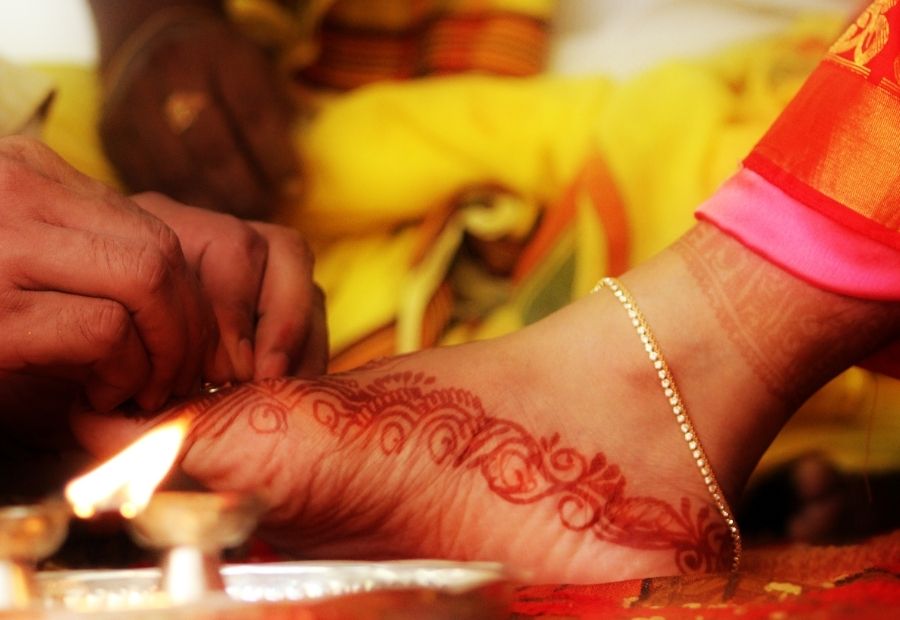This article on “Increasing the Marriageable Age of Women From 18 to 21” is written by Tanisha Bamboria. She is pursuing Law from Mohan Lal Sukhadia University, Udaipur; and is Content Writer & Legal Researcher at Legal Thirst.
“Increasing the legal age of women’s marriage from 18 to 21: A Dominant strategy for societal good and financially empowering women”.
Marriages are made in heaven; is an abdage. A woman leaves her parental home for the matrimonial home. She not only leaves her memories but also her surname, gotra, maidenhood. Men and women are a perfect whole in a marriage, strength comes from their union and separation leads to their weakness. But if we look at the status of women in Indian society; there is still huge gender disparity among married couples or men and women in modern times. The women in spite of their legal rights enshrined in our constitution are facing oppression and are not considered equal as men. The basic reason behind that is illiteracy among women’s.
In order to reduce gender-disparity and to promote gender-neutrality; last year the Government of India has set up a committee to reconsider legal age of marriage for girls from 18 to 21.
“A Bird cannot fly with one wing only, a nation cannot march forward if the women are left behind”.
Swami Vivekananda
Table of Contents
How has Law on Marriage Evolved Over Years?
- The Indian penal code enacted in 1860 criminalised sexual intercourse with girl below the age of 10.
- A legal framework for age of consent for marriage in India only began in 1880s.
- Women rights activist pressured the British Government to bring about age of consent bill 1927 that made marriage with a girl less than 12 year age illegal.
Sarda Act:
Members of the All India Women’s Conference, Women’s Indian Association and National Council of Women in India. They presented their argument to raise minimum age of marriage. On 28 September 1929 the Imperial Legislative Council passed the CHILD MARRIAGE RESTRAINT ACT 1929. It set a minimum age of marriage as 16 years for women and 18 years for men. This act is popularly known as SARDA ACT as it was sponsored by Rao Sahib Harbilas Sarda who was a retired judge and a member of Arya Samaj.
In 1978 the law was amended to raise the minimum age of marriage to 18 years for girls and 21 years for boys. According to the law if marriage had occurred between a boy aged between 18-21 and a girl below 18 year age, it implied an imprisonment of 15 days along with a fine of one thousand rupees. This position remained the same till the new law of PROHIBTION OF CHILD MARRIAGE ACT 2006.
Current Laws:
HINDU MARRIAGE ACT 1955
Under section 5 for Hindus this law sets 18 years as a minimum age of marriage for brides and 21 as for the groom.
In Islam the age of marriage is determined when the women attains puberty i.e., 15 years age. The minor of the marriage who has attained puberty is considered valid as per the MUSLIM PERSONAL LAW.
SPECIAL MARRIAGE ACT 1954:
It prescribes18 as legal age of marriage for girls and 21 for boys. In this act people could get married to each other irrespective of their faith and religion.
PROHIBTION OF CHILD MARRIAGE ACT 2006:
Also prescribes 21 and 18 year as legal age of marriage for men and women respectively. The law seeks to prevent child marriages by making certain action punishable. Child marriage is an offence which is punishable with rigorous imprisonment; which may extend to 2 years or with fine upto Rs.1 lakh or both. The offences under the act are cognizable and non-bailable.
Persons who can be punished under the law:
- Whoever performs, directs, conducts and abets child marriage.
- A male adult above 18 years marrying a child (section 9)
- Parent, guardian, any member of organization or association, promoting, permitting, participating in child marriage.
Need for Relooking to Raise the Marriage:
Due to unwanted pregnancies, no health facilities and lack of nutrition the women under the age of 18-20 age faces complications and died at large numbers. According to UNICEF in India death due to pregnancy complications is 3500 women’s died between 15-19 years in 2017; because of lack of education, poor economic status and no access to better health care facilities.
Children born to adolescent mother are more likely to die and have stunted growth and health related issues. They are 11% points more stunted than children born to adult mothers; because of no proper availability of nutrition to them and lack of education.
To deter child marriages: Economically weak and large families encourage early child marriage as it helps send-off girl; while marriage of a boy brings an additional hand to assist in household and economic activities. Also the members of family have little or no formal education; Belief in religious scriptures and old traditions lead to marriage of girls at early age. Also the incentive of dowry perpetuates child marriage as it is still common for parents of girls to give gifts to groom; and as the age and education level of girls increases, dowry amounts also increases.
Result of Child Marriage:
- Early maternal and infant deaths
- Adolescent mothers give pre matured babies and low weight child.
- Child brides often exposed to early pregnancy and various STD (AIDS/HIV)
- Enslavement, exploitation, domestic violence.
Impact to Increase Age of Marriage
Pros
The proposal to raise the legal age of marriage of women carries economic and societal gains for India. It counts benefits such as lowering maternal deaths (MMR), child mortality rates, improving nutritional levels, enabling more girls to enrol in schools and to gain financial independence in a long term.
Access to Education:
- It lowers the MATERNAL MORTALITY RATE (MMR) and INFANT MORTALITY RATE (IMR)
- Nutrition level increases of both mother and the child and reduce in number of pregnancy related risks such as HIV/AIDS.
- Reduce child marriages: if the law is strictly followed the evil of child marriage would stop at some level
- Financial front opportunities will be opened to pursue higher education and become financially empowered thus resulting in more egalitarian society and promotes gender-neutrality and gender-equality.
Cons
But at the same time, the increasing age of marriage will cause harm to women, unless the root cause of societal issues and traditional mindsets of people are not being addressed. Some of them are:
- The national coalition advocating for adolescent concerns that it will only “artificially expand the numbers of married persons deemed underage and also increase the underage married girls without legal protection.
- Traditional perceptions of people: still in modern times most people considered women as burden, by increasing the age of marriage the parents would feel more burdened and forced them to marry below their legal issues.
- Poverty and poor economic conditions make women vulnerable to access to education, proper health and this lead to child marriages or female infanticide and sex selective abortion.
- No legal protection to young widows as by increasing the age of marriage their marriage would no longer consider legal and would not get support after she loose all her legal rights.
Conclusion
For any society to make sustainable change it is necessary to empower women and for that; important weapons are skill and quality education. Government needs to emphasis upon the social and economic empowerment of women through free schooling , access to better health care opportunities, nutritional food , anganwadis in all government schools, transportation facility, job and career opportunities , several campaigns and NGOS to educate girls about pregnancy related risks and birth control methods, strict legal actions on child marriages and also there is need for parity among men and women to promote gender equality and gender-neutrality and for that increasing age of marriage is a dominant strategy to empower women in societal and financial sphere.
Disclaimer: The opinions and views in the articles and research papers published on this website; are personal and independent opinions of the author. The website is not responsible for them.
Legal Thirst has created a telegram group for exchanging legal knowledge, Events, and various opportunities.
You can click on this link and join:
Follow Legal Thirst on Instagram and Subscribe to our YouTube channel for more amazing legal content.



